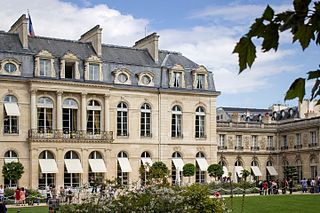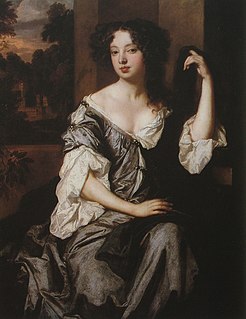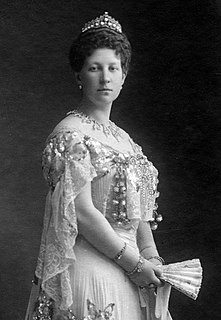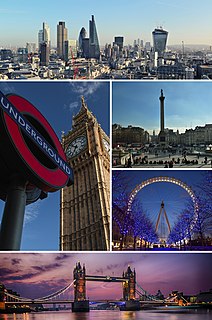
Wallis Simpson, later known as the Duchess of Windsor, was an American socialite whose intended marriage to the British king Edward VIII caused a constitutional crisis that led to Edward's abdication.

Mary of Teck was Queen consort of the United Kingdom and the British Dominions and Empress consort of India as the wife of King George V.

Diane de Poitiers was a French noblewoman and a prominent courtier at the courts of kings Francis I and Henry II.

The Élysée Palace is the official residence of the President of the French Republic. Completed in 1722, it was initially built for Louis Henri de La Tour d'Auvergne. It was used as the office of the French President for the first time in 1848. The current building contains the presidential office and residency, as well as the meeting place of the Council of Ministers. It is located near the Champs-Élysées in the 8th arrondissement of Paris, the name Élysée deriving from Elysian Fields, the place of the blessed dead in Greek mythology. Important foreign visitors are hosted at the nearby Hôtel de Marigny, a palatial residence.

Kensington Palace is a royal residence set in Kensington Gardens, in the Royal Borough of Kensington and Chelsea in London, England. It has been a residence of the British Royal Family since the 17th century, and is currently the official London residence of the Duke and Duchess of Cambridge, Princess Eugenie and her husband Jack Brooksbank, the Duke and Duchess of Gloucester, the Duke and Duchess of Kent, and Prince and Princess Michael of Kent.

Eleanor Gwyn, more commonly known as Nell Gwyn, was a prolific celebrity figure of the Restoration period. Praised by Samuel Pepys for her comic performances as one of the first actresses on the English stage, she became best known for being a long-time mistress of King Charles II of England and Scotland. Called "pretty, witty Nell" by Pepys, she has been regarded as a living embodiment of the spirit of Restoration England and has come to be considered a folk heroine, with a story echoing the rags-to-royalty tale of Cinderella. Gwyn had two sons by King Charles: Charles Beauclerk (1670–1726) and James Beauclerk (1671–1680). Charles was created Earl of Burford and later Duke of St. Albans.

Louise Renée de Penancoët de Kérouaille, Duchess of Portsmouth was a mistress of Charles II of England.

Ehrengard Melusine von der Schulenburg, Duchess of Kendal, Duchess of Munster was a longtime mistress to King George I of Great Britain.

Princess Mary, Duchess of Gloucester and Edinburgh was the eleventh child and fourth daughter of King George III of the United Kingdom and his consort Charlotte of Mecklenburg-Strelitz.

Marble Hill House is a Palladian villa built between 1724 and 1729 in Twickenham in the London Borough of Richmond upon Thames. It was the home of Henrietta Howard, Countess of Suffolk, who lived there until her death. The compact design soon became famous and furnished a standard model for the Georgian English villa and for plantation houses in the American colonies.
Petronilla Melusine von der Schulenburg, Countess of Walsingham was the natural daughter of King George I of Great Britain and his longtime mistress, Melusine von der Schulenburg, Duchess of Kendal.

Grand Duchess Alexandra Iosifovna of Russia, born Princess Alexandra Friederike Henriette of Saxe-Altenburg, was the fifth daughter of Joseph, Duke of Saxe-Altenburg and Amelie Theresa Luise, Duchess of Württemberg. She is an ancestor of the British, Greek, Romanian, Yugoslavian and Spanish Royal Families through her elder daughter Olga.

Princess Maria of Greece and Denmark was a daughter of King George I of Greece and his wife Grand Duchess Olga Constantinovna of Russia. She was a sister of King Constantine I of Greece and a first cousin of Tsar Nicholas II of Russia.

Sophia Dorothea of Brunswick-Lüneburg-Celle was the repudiated wife of future King George I of Great Britain, and mother of George II. The union with her first cousin was an arranged marriage of state, instigated by the machinations of his mother, Electress Sophia of Hanover. She is best remembered for her alleged affair with Philip Christoph von Königsmarck that led to her being imprisoned in the Castle of Ahlden for the last thirty years of her life.

Marie Angélique de Scorailles was a French noblewoman and one of the many mistresses of Louis XIV. A lady-in-waiting to his sister-in-law Elizabeth Charlotte, Princess Palatine, the Duchess of Orléans, she caught the attention of the Sun King and began an affair with him in 1679. She died two years later, most probably as a result of complications arising from childbirth.

Princess Augusta Frederica of Great Britain was a British princess, granddaughter of King George II and the only elder sibling of King George III. She was a Duchess consort of Brunswick by marriage to Charles William Ferdinand, Duke of Brunswick-Wolfenbüttel. Her daughter Caroline was the spouse of King George IV.

Alice Frederica Keppel was a British society hostess and a long-time mistress of King Edward VII.

Sophia Charlotte von Kielmansegg, Countess of Darlington and Countess of Leinster was a German-born British courtier and a half-sister of George I of Great Britain.

Louise Élisabeth de Bourbon was a daughter of Louis III de Bourbon, Prince of Condé, and his wife, Louise Françoise de Bourbon, légitimée de France, a legitimised daughter of King Louis XIV of France and his famous mistress, Madame de Montespan.

Amalie Sophie Marianne von Wallmoden, Countess of Yarmouth, born Amalie von Wendt was the principal mistress of King George II from the mid-1730s until his death in 1760. Born into a prominent family in the Electorate of Hanover, and married into another, in 1740 she became a naturalised subject of Great Britain and was granted a peerage for life, with the title of "Countess of Yarmouth", becoming the last royal mistress to be so honoured. She remained in England until the death in 1760 of King George II, who is believed to have fathered her second son, Johann Ludwig, Reichsgraf von Wallmoden-Gimborn. She returned to Hanover for the rest of her life, surviving the king for nearly five years.























